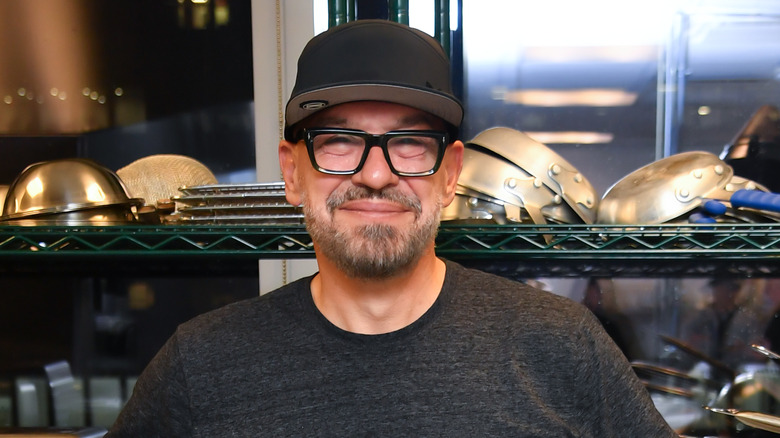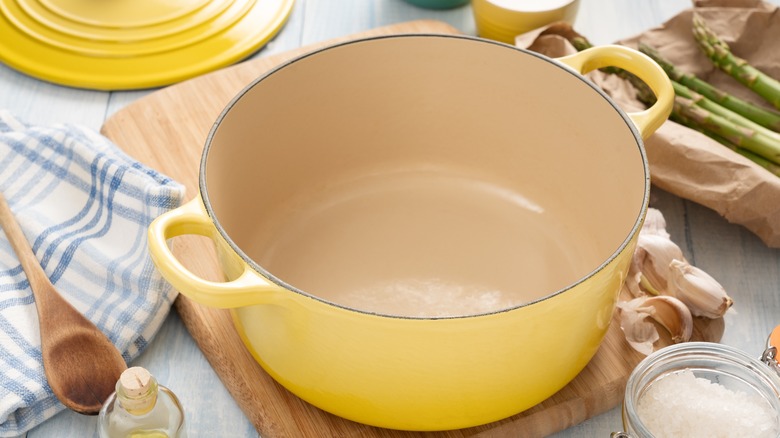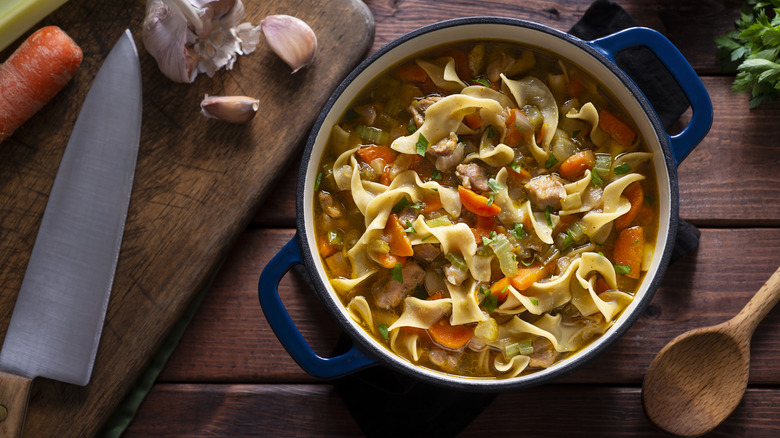The Industry Product Michael Symon Uses To Clean His Dutch Oven
Dutch ovens make a statement on the stovetop. In addition to their status as a workhorse in the kitchen, the cooking equipment comes in a rainbow of colors and a multitude of shapes and sizes. Their beauty, versatility, and heating abilities has attracted legions of fans across social media and professional kitchens.
Among those fans is restaurateur and cookbook author Michael Symon. The celebrity chef also keeps a special product in his back pocket to clean the kitchen tool and any reminders of meals past: Bar Keepers Friend. He tells followers on X, formerly Twitter, that the solution will have enameled cookware looking "like new with a little elbow grease."
The brand sells both a powdered cleaner and a liquid solution to combat seriously discolored spots. Though Symon doesn't specify his preference, both forms of the product contain the cleaning agent oxalic acid and will likely do the trick. The powder allows you to concentrate or dilute as needed, whereas the liquid is pre-mixed and better at clinging to lighter stains. One note, however, is that while even Le Creuset recommends the $3 product, this is only a solution for enameled surfaces, not cast iron.
Removing stains from enamel
Before investing in another cleaning product, it might be helpful to know there are a few different approaches you can take to clean a burnt Dutch oven. You can start with an even more affordable product, tap water, and boil it in the pot for about three minutes. Scrape with a wooden spoon to loosen and remove scorching and stains. To amp up the scour power, you can also add baking soda to the Dutch oven as the water boils.
The goal here is to clean gently, using a sponge or rag, rather than forcefully scrubbing the surface with a metal spatula or steel wool, which can scratch the enamel. Dutch ovens are designed to last, but they're only helpful if they've still got their nonstick coating. That's why, if all else fails, chefs tap into the power of oxalic acid, which cleans and brightens that precious enamel, as well as stainless steel and porcelain sinks.
Once you've succeeded in removing the worst gunk, make sure to avoid chasing the boiling water with a shock of cold tap water. Even the fanciest pans are vulnerable to thermal shock, which means the interior can flake or crack if the pot goes from hot to cold too quickly. Though manufacturers will indicate if your equipment can go in the dishwasher, we suggest avoiding the machine as much as possible to maintain the interior's glossy shine.
Maximizing your Dutch oven
Now that you've got a plan for cleanup, make sure to put that pot to use. Chef Michael Symon, who told his X followers there's no pan he uses more than his cast iron enamel Dutch oven, has plenty of ideas to maximize the versatile tool. The affable Food Network star makes everything from fish to pot roast in his.
Symon's trick for cooking a vibrant tomato sauce and tender fish in one pot? He simmers the vegetable mixture on the stove before adding fillets and moving the meal to the oven. The chef takes advantage of a cast iron Dutch oven's ability to move seamlessly from different heat sources, warming gently and consistently no matter where you use it.
The chef also puts his pot to the test making French onion soup, which relies on heavy caramelization and plenty of red wine. The process shows off the Dutch oven's browning capabilities and nonstick surface. To really make the most of the pot, ambitious home cooks can go a step further and bake a loaf of crusty bread in the cast iron as well.



